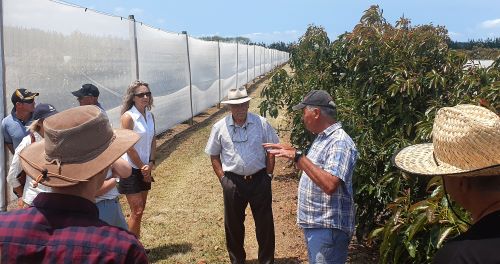Tour shows how water can transform ‘marginal’ land
20 Dec 2019, 11:37 AM
Those driving a multimillion dollar project investigating potential Kaipara and Far North-based water storage and use options have held two days of field trips to show how water has transformed marginal farmland intro highly productive horticulture.
Two initial studies – co-funded by the Northland Regional Council (NRC) and central government – have already identified about 6300 hectares of potential land some of which may be suitable for conversion to high value horticulture in Kaipara as part of a water supply scheme, another 1600ha south of Kaikohe and 1700ha to the west of Lake Omapere.
 Northland Water Storage and Use Advisory Group Crown appointee Dover Samuels, centre, is briefed by landowner John Greensmith on the difference water has made to his avocado orchard at Tapora, near Wellsford.
Northland Water Storage and Use Advisory Group Crown appointee Dover Samuels, centre, is briefed by landowner John Greensmith on the difference water has made to his avocado orchard at Tapora, near Wellsford.
Council Chair Penny Smart says overall, Northland has a lot of water “but unfortunately not always at the right time”. “A lot of it comes at once and at its heart, the project is about collecting water and making it available when it’s needed.”
The project recently reached an important pre-feasibility demand assessment and design stage which has seen major Northland landholders contacted to gather information needed to answer key questions, including what water could be used for given local soil types, land profile and climate.
As well as assess water user/grower demand, the prefeasibility stage – which has a budget of up to $3M – is also looking at where and how water could be collected, stored and distributed.
Initial indications are that with the availability of a secure water supply, horticulture and supporting industry could ultimately create hundreds of jobs and boost Northland’s economy by tens of millions annually. This potential was reinforced in July when the project received an $18.5 million boost from the Provincial Growth Fund.
At a local level, the regional council is leading the project in collaboration with the Far North and Kaipara District Councils and Northland Inc
Chair Smart says the true value of water to horticulture can be difficult to grasp by just seeing reports and taking part in discussion.
With that in mind and to aid understanding of what water potentially allows, the council had recently organised two field trips (12 & 13 December) to look at horticulture operations in the Far North (including the Aupouri peninsular and Kerikeri), as well as at Tapora, near Wellsford, on the edge of the Kaipara Harbour.
Forty-six people in total had attended over the two days including landowners, farmers, tangata whenua and government staff.
“The field trips were a definite eye-opener for some, who saw first-hand how land that had been considered ‘marginal at best’ for farming had been transformed by water into highly productive horticulture.”
Technology and innovation are at the forefront in managing water use, costs and sustainability, with the latter a key consideration in Northland where any local economic growth needs to be done in an environmentally and culturally sensitive way.
Chair Smart says water is just one of the components – albeit a key one – to transforming land.
“The market for horticultural produce is growing worldwide, however, the level of investment needed for large land transformation is considerable.”
She says elsewhere in New Zealand high value horticultural land is being lost to subdivision, making land development options in Northland more appealing.
“And of course, along with land and water, having a pool of workers to employ is also critical to success.”
Chair Smart says ultimately, any change in land use for water storage/use will need to fit with the four well-beings that all councils must allow for; social, economic, environmental and cultural.
“Environmental sustainability and enhancement will be crucial, as will a willingness to adopt emerging sustainable land use technologies.”
